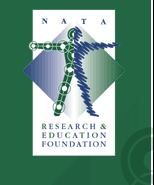|
PRACTICAL
SIGNIFICANCE
This
study
provides
evidence
that
females
perform
athletic
tasks in
a way
that may
predispose
them to
ACL
injuries,
and that
participation
in a
training
program
may
prevent
the
emergence
of
potentially
injurious
movement
patterns.
STUDY
BACKGROUND
Non-contact
ACL
injuries
are one
of the
most
common
knee
injuries
sustained
by
individuals
who
engage
in
athletics.
Comparison
of
injury
rates
between
male and
female
athletes
participating
in
similar
sports
show
that
there is
a
greater
incidence
of ACL
injuries
in
females.
Numerous
theories
have
been
proposed
to
explain
the
higher
incidence
of ACL
injuries
in
females,
however
exact
mechanisms
and risk
factors
have not
been
adequately
defined.
One area
that has
received
little
attention
is
whether
females
perform
specific
sports
maneuvers
that may
predispose
them to
ACL
injuries.
OBJECTIVE
Three
studies
were
performed
to meet
the
following
objectives:
1)
identify
aspects
of
performance
that may
predispose
female
athletes
to
non-contact
ACL
injuries,
2)
evaluate
the
effects
of
experience
on the
performance
of
athletic
activities,
and 3)
assess
the
effectiveness
of a
training
program
in
altering
potentially
injurious
lower
extremity
mechanics.
DESIGN
AND
SETTING
Studies
I and II
were
cross-sectional
designs.
Study
III was
a
controlled
trial
that
incorporated
a
repeated
measures
design.
All
three
studies
were
performed
in a
laboratory
setting.
SUBJECTS
Study I
compared
experienced
male
(n=15)
and
female
(n=15)
collegiate
soccer
players,
while
study II
compared
novice
(n=15)
and
experienced
(n=15)
female
high-school
soccer
players.
Study
III
evaluated
female
high
school
soccer
players
(n=20)
before
and
after an
intervention
program
and
female
high
school
soccer
players
(n=19)
not
participating
in the
intervention
program.
MEASUREMENTS
Dependent
variables
analyzed
in all
three
studies
included
3D knee
kinematics,
3D knee
kinetics,
and
normalized
EMG
activity
of
quadriceps
and
hamstrings.
All data
were
obtained
during a
side-step
cutting
maneuver.
(Figure
1)
RESULTS
Results
from
Study I
found
that
during
early
deceleration,
females
experienced
greater
frontal
plane
moments
(0.43 +
0.5 vs.
0.006 +
0.3 N/m
kg; p<
0.01),
smaller
sagittal
plane
moments
(2.1 +
0.84 vs.
1.4 +
0.77 N/m
kg;
p<0.05)
and
greater
quadriceps
activation
(191 vs.
151%
MVIC,
p<0.02)
than
males.
Contrary
to our
original
hypothesis,
Study II
found
that
novice
females
demonstrated
significantly
smaller
knee
moments
in the
sagittal,
frontal
and
transverse
planes
and 58%
greater
muscle
co-contraction
than
experienced
females.
In Study
III,
significant
post-season
increases
in
frontal
and
transverse
plane
knee
force
impulses
were
seen in
the
control
group
(17.5%
and
19.0%
respectively),
while no
changes
were
observed
in the
group
participating
in the
intervention
program.
CONCLUSIONS
The
results
of this
study
provide
evidence
that
female
athletes
perform
a
side-step
cutting
maneuver
differently
than
males
and that
the
biomechanical
pattern
demonstrated
by
females
is
suggestive
of
increased
risk for
ACL
injury.
Furthermore,
it
appears
that the
“at
risk”
patterns
in
females
increases
with
athletic
experience.
Participation
in an
injury
intervention
program
may act
to
prevent
the
emergence
of
potentially
injurious
movement
patterns.
Figure
1:
Motion
Capture
Model
and Data
Collection
Picture

|
Publication
&
Presentation
List:
-
NATA
Annual
Meeting,
Baltimore,
MD,
June
15-19,
2004
-
Powers
CM,
Sigward
SM,
Ota
S,
Pelley
K.
The
influence
of
gender
on
knee
kinematics,
kinetics
and
muscle
activation
patterns
during
side-step
cutting.
Journal
of
Athletic
Training
39(2):S14,
2004
-
Sigward
SM,
Ota
S,
Pelley
K,
Powers
CM.
The
influence
of
experience
on
knee
kinematics,
kinetics
and
muscle
activation
patterns
in
young
female
athletes.
Journal
of
Athletic
Training
39(2):S27,
2004
-
Powers
CM,
Sigward
SM,
Ota
S,
Pelley
K.
The
influence
of
an
ACL
injury
training
program
on
knee
mechanics
during
a
side-step
cutting
maneuver.
Journal
of
Athletic
Training
39(2):S27,
2004
|
|
|
|

Christopher Powers, PhD, PT
Principal Investigator
|
Christopher Powers, PhD, PT is an Associate Professor in the Division of Biokinesiology & Physical Therapy, and Co-Director of the MBRL at USC. He also has joint appointments in the Departments of Radiology and Orthopaedic Surgery within the Keck School of Medicine. His primary teaching responsibilities include the areas of biomechanics and the mechanics of human gait. He received a Bachelors degree in Physical Education from the University of California, Santa Barbara in 1984, his Masters degree in Physical Therapy from Columbia University in 1987, and a Ph.D. in Biokinesiology in 1996 from USC. Dr. Powers did his post-doctoral training at the Orthopaedic Biomechanics Laboratory, University of California, Irvine.
Christopher Powers, PhD, PT
Division of Biokinesiology & Physical Therapy
CHP-155
1540 Alcazar St., CHP 155
Los Angeles, CA 90089-9006
(323) 442-1928
powers@usc.edu |
|
|
This
Grant
Information
Summary
may be
downloaded
in a
2-page
pdf file
from
http://www.natafoundation.org/PDF/Powers.pdf. |
Back to
December
28, 2010
eBlast
Newsletter
Send e-mail
to rachaelo@nata.org with questions
or
comments
about this web site. |


